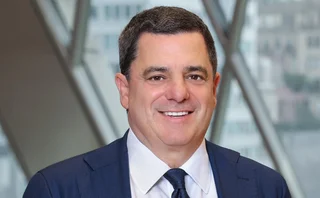
Derivatives client clearer of the year: Barclays
Risk Awards 2024: Internal reorg revived sagging clearing business and delivered for clients

Back in 2016, Barclays realised it was missing a trick with its financing and derivatives clearing businesses. The fixed income financing operation was flying high. But the prime services business had been relegated to a niche, catering primarily to quant funds, while derivatives clearing had become an afterthought.
The decision was made to integrate the businesses and invest in the combined offering, which Barclays calls prime derivatives services. Mike Webb, head of liquid financing, says the idea was to create “a top tier business that delivers a fully integrated financing and clearing platform tightly connected into our markets division”.
The plan came together in 2019, when the risk teams were fully combined as part of the integration, among other changes. This, coupled with the bank’s long-standing global netting agreement (GNA) – a legal construct that facilitates dynamic cross-margining of different asset classes and product types – has given Barclays an unparalleled view of risk and incentivised clients to run more balanced portfolios with the bank. “A client trading interest rate futures, clearing over-the-counter swaps and doing repo, we’re looking at that as a holistic risk, as opposed to siloed,” says Webb.
[The idea was to create] a top tier business that delivers a fully integrated financing and clearing platform tightly connected into our markets division
Mike Webb, Barclays
The approach has proven particularly advantageous when dealing with more complex relative value strategies, such as the US Treasury basis trade, which have grown in popularity as markets have become more dislocated.
Clients also like what Barclays has done. The head of operations at a large asset management firm describes the bank’s cross-margining system as “elegant”, and credits Barclays for “thinking about risk management up front”. A chief operations officer (COO) at a hedge fund also praises Barclays for its “joined-up and holistic” approach, which he contrasts with other banks where the markets businesses “don’t talk” to their colleagues in clearing.
The changes have transformed the clearing business. Global client clearing revenues have grown 55% since 2018 and nearly doubled in the Americas. Over the same period, comparable revenues at US banks grew by 13%, according to Coalition Greenwich, and dropped 10% for European banks.
The amount of required client margin held by Barclays for swaps trades in the US increased 21% over the 12 months that ended in August to an all-time high of $15.5 billion, according to data from the US Commodity Futures Trading Commission. Barclays now ranks as the largest non-US futures commission merchant (FCM) measured by client margin – and the sixth-largest overall – with a market share of almost 10%.
The new strategy has also helped Barclays to diversify its business mix. Balances with asset managers have grown by 25% since 2018, and while hedge funds still represent almost half the client base, market-makers – a smaller client segment – have almost doubled the amount of clearing business they send to Barclays.
And while much of the bank’s recent success in clearing is the result of strategic and organisational changes, clients also applaud Barclays for its attention to detail and commitment to getting the small things right. One example is the ability to handle bond deliveries, which is crucial for clients engaged in basis trading. Barclays was also the first FCM to facilitate the posting of US Treasury exchange-traded funds as collateral at CME, and has partnered with the Depository Trust and Clearing Corporation to develop a regulatory reporting solution for clients.
Webb points to these developments as evidence of the bank’s renewed commitment to the clearing business. “It continues to be an area of focus for the firm and you see that in the investments we are making with financial resources, human capital and technology. Our senior leadership are committed and vocal in their support of this business, and all this allows us to hold our most important and complex clients close to the franchise on a daily basis,” he says.
Stand and deliver
Barclays’ model has made it a popular choice for clients looking to clear the futures leg of the US Treasury basis trade – which typically involves buying the underlying bonds with repo financing and shorting the futures to capitalise on any price gaps.
Regulators have expressed concerns about the strategy, which they claim can be levered up to 50 or 70 times. While technically possible, that assumes firms active in the trade are only charged contract margins on the futures leg and can obtain repo financing without haircuts from dealers that may be unaware of the full extent of the risks their clients are running.
The GNA allows Barclays to look at the overall risk of the trade, including the uncleared repo financing leg. While recognising offsets between the cash and futures legs, Barclays also runs stress tests on the netting sets to gauge the interaction between the positions and can charge additional margin beyond what is required by the clearing house.
“The basis trade is just one example of the kind of trades we manage within that GNA construct,” says Gary Saunders, head of prime derivatives services. “We think it gives us a better risk profile and gives the client a consistent approach to managing their risk. The risk calculation is dynamic but transparent.”
There’s more to clearing the basis trade than setting margin requirements. One of the most overlooked but important aspects of the trade is the settlement of bond deliveries. Bond futures at most exchanges, including CME and Eurex, are deliverable, meaning if a contract is held to maturity, the underlying assets must be delivered to the clearing house by the seller so the buyer can take delivery. Failure to make or accept delivery can result in significant economic and regulatory penalties, both for the failing party and its clearing firm.
The GNA construct gives us a better risk profile and gives the client a consistent approach to managing their risk
Gary Saunders, Barclays
Facilitating bond deliveries is barely profitable, but Barclays has invested heavily in this capability and is consistently ranked among the top three providers.
“It’s potentially not as high-returning as you would like, if viewed as a standalone, but combined with other revenues from other parts of the liquid financing franchise, it’s the right thing to do for certain clients, which is consistent with our holistic approach to the cross-product offering,” says Craig Robertson, head of prime derivatives services in the US.
That investment paid off in a big way when hedge funds and proprietary trading firms began piling into the US Treasury basis trade earlier this year. “In the US product, we’ve actually pushed more activity their way, because they have been offering us additional balance sheet capacity for physical delivery from cleared futures,” says the COO of a large hedge fund. “They were one of our largest providers, which for a UK-based bank does set them apart from large US banks, a couple of whom were nowhere to be seen.”
Data from CME shows that in the June cycle for 10-year US Treasury futures – when volatility was surging – Barclays easily delivered the most lots, relegating Bank of America and JP Morgan to second and third spot.
The demand for this service was even greater in Europe. In the June delivery cycle, two large US banks “completely pulled away” from facilitating the physical delivery of European government bond futures at Eurex, according to the hedge fund COO. “These were two wholesale providers to the Street that had been providing that type of facility, not just to us but to other funds. And they literally said ‘no’ three weeks before the roll,” he explains. “We called Barclays and even though they did have some concentration issues, they managed to pull out some additional capacity.”
Clearing the hurdle
Clients shared plenty of other examples of Barclays going the extra mile to meet their needs. The head of derivatives at a large asset manager says his firm switched to the bank after its previous clearing provider struggled to deliver the infrastructure to manage its margin-related FX risk. “Barclays actually built a solution for us prior to onboarding,” he says. It is also assisting the firm with a new regulatory reporting solution, this person adds.
Mark Wendland, COO at proprietary trading firm DRW, has also been impressed with Barclays’ approach. “They’re not a vendor or a provider, they’re a partner,” he says. “And they are able to serve us so effectively because they took the time to understand our firm and our needs.”
Clients view us as an entity providing a service, so we have a singular balance sheet conversation
Mike Webb, Barclays
Webb ties this back to the decision to integrate the fixed income financing, prime services and derivatives clearing businesses. This means Barclays now looks at the total revenue generated by a client across a range of activities and then compares that to the financial, operational, human capital and technology resources they consume. “We don’t look at any one product or service in a particular region in isolation and say, ‘it’s not meeting the return hurdle’. Clients view us as an entity providing a service, so we have a singular balance sheet conversation.”
The strategy recognises that clearing is just one part of a relationship with clients that are “trading more products and engaging in more complex things in multiple jurisdictions”, says Webb.
The exit of Credit Suisse from the clearing business in 2021 gave Barclays a chance to validate its strategy and accelerate its growth plans. It fought off competition from rival clearers and prime brokers to pick up a large chunk of the Swiss bank’s clients – especially asset managers – before it was ultimately acquired by UBS in March. Last year, Barclays also recruited 18 staff from Credit Suisse’s prime brokerage business to fuel its expansion.
Webb says the integration of clearing with other parts of the bank played a role. “The organisation already had relationships with many of these top asset managers by trading with them across the corporate and investment bank,” he says. “What we did was play as a team to expand the relationships with these asset managers into derivatives clearing.”
Only users who have a paid subscription or are part of a corporate subscription are able to print or copy content.
To access these options, along with all other subscription benefits, please contact info@risk.net or view our subscription options here: http://subscriptions.risk.net/subscribe
You are currently unable to print this content. Please contact info@risk.net to find out more.
You are currently unable to copy this content. Please contact info@risk.net to find out more.
Copyright Infopro Digital Limited. All rights reserved.
As outlined in our terms and conditions, https://www.infopro-digital.com/terms-and-conditions/subscriptions/ (point 2.4), printing is limited to a single copy.
If you would like to purchase additional rights please email info@risk.net
Copyright Infopro Digital Limited. All rights reserved.
You may share this content using our article tools. As outlined in our terms and conditions, https://www.infopro-digital.com/terms-and-conditions/subscriptions/ (clause 2.4), an Authorised User may only make one copy of the materials for their own personal use. You must also comply with the restrictions in clause 2.5.
If you would like to purchase additional rights please email info@risk.net
More on Awards
Market liquidity risk product of the year: Bloomberg
Bringing clarity and defensibility to liquidity risk in a fragmented fixed income market
FRTB (SA) product of the year: Bloomberg
A globally consistent and reliable regulatory standardised approach for FRTB
Best use of cloud: ActiveViam
Redefining high-performance risk analytics in the cloud
Best use of machine learning/AI: ActiveViam
Bringing machine intelligence to real-time risk analytics
Collateral management and optimisation product of the year: CloudMargin
Delivering the modern blueprint for enterprise collateral resilience
Flow market-maker of the year: Citadel Securities
Risk Awards 2026: No financing; no long-dated swaps? “No distractions,” says Esposito
Pricing and analytics: fixed income – Quantifi
Quantifi delivers high-performance, transparent and adaptable pricing and risk analytics for fixed income and credit markets
Derivatives house of the year: Citi
Risk Awards 2026: Rev up, RWAs down, as US bank gets back on track (with added XiNG and XiP)








